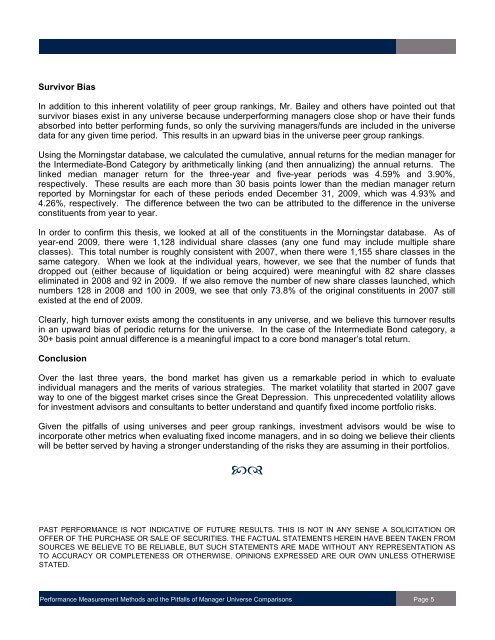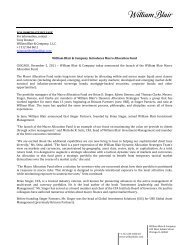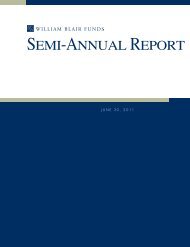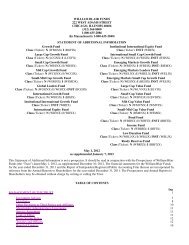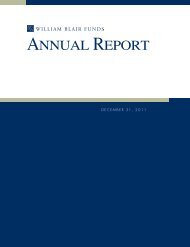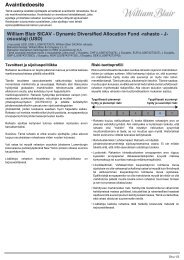Performance Measurement Methods and the Pitfalls ... - William Blair
Performance Measurement Methods and the Pitfalls ... - William Blair
Performance Measurement Methods and the Pitfalls ... - William Blair
You also want an ePaper? Increase the reach of your titles
YUMPU automatically turns print PDFs into web optimized ePapers that Google loves.
Survivor Bias<br />
In addition to this inherent volatility of peer group rankings, Mr. Bailey <strong>and</strong> o<strong>the</strong>rs have pointed out that<br />
survivor biases exist in any universe because underperforming managers close shop or have <strong>the</strong>ir funds<br />
absorbed into better performing funds, so only <strong>the</strong> surviving managers/funds are included in <strong>the</strong> universe<br />
data for any given time period. This results in an upward bias in <strong>the</strong> universe peer group rankings.<br />
Using <strong>the</strong> Morningstar database, we calculated <strong>the</strong> cumulative, annual returns for <strong>the</strong> median manager for<br />
<strong>the</strong> Intermediate-Bond Category by arithmetically linking (<strong>and</strong> <strong>the</strong>n annualizing) <strong>the</strong> annual returns. The<br />
linked median manager return for <strong>the</strong> three-year <strong>and</strong> five-year periods was 4.59% <strong>and</strong> 3.90%,<br />
respectively. These results are each more than 30 basis points lower than <strong>the</strong> median manager return<br />
reported by Morningstar for each of <strong>the</strong>se periods ended December 31, 2009, which was 4.93% <strong>and</strong><br />
4.26%, respectively. The difference between <strong>the</strong> two can be attributed to <strong>the</strong> difference in <strong>the</strong> universe<br />
constituents from year to year.<br />
In order to confirm this <strong>the</strong>sis, we looked at all of <strong>the</strong> constituents in <strong>the</strong> Morningstar database. As of<br />
year-end 2009, <strong>the</strong>re were 1,128 individual share classes (any one fund may include multiple share<br />
classes). This total number is roughly consistent with 2007, when <strong>the</strong>re were 1,155 share classes in <strong>the</strong><br />
same category. When we look at <strong>the</strong> individual years, however, we see that <strong>the</strong> number of funds that<br />
dropped out (ei<strong>the</strong>r because of liquidation or being acquired) were meaningful with 82 share classes<br />
eliminated in 2008 <strong>and</strong> 92 in 2009. If we also remove <strong>the</strong> number of new share classes launched, which<br />
numbers 128 in 2008 <strong>and</strong> 100 in 2009, we see that only 73.8% of <strong>the</strong> original constituents in 2007 still<br />
existed at <strong>the</strong> end of 2009.<br />
Clearly, high turnover exists among <strong>the</strong> constituents in any universe, <strong>and</strong> we believe this turnover results<br />
in an upward bias of periodic returns for <strong>the</strong> universe. In <strong>the</strong> case of <strong>the</strong> Intermediate Bond category, a<br />
30+ basis point annual difference is a meaningful impact to a core bond manager’s total return.<br />
Conclusion<br />
Over <strong>the</strong> last three years, <strong>the</strong> bond market has given us a remarkable period in which to evaluate<br />
individual managers <strong>and</strong> <strong>the</strong> merits of various strategies. The market volatility that started in 2007 gave<br />
way to one of <strong>the</strong> biggest market crises since <strong>the</strong> Great Depression. This unprecedented volatility allows<br />
for investment advisors <strong>and</strong> consultants to better underst<strong>and</strong> <strong>and</strong> quantify fixed income portfolio risks.<br />
Given <strong>the</strong> pitfalls of using universes <strong>and</strong> peer group rankings, investment advisors would be wise to<br />
incorporate o<strong>the</strong>r metrics when evaluating fixed income managers, <strong>and</strong> in so doing we believe <strong>the</strong>ir clients<br />
will be better served by having a stronger underst<strong>and</strong>ing of <strong>the</strong> risks <strong>the</strong>y are assuming in <strong>the</strong>ir portfolios.<br />
<br />
PAST PERFORMANCE IS NOT INDICATIVE OF FUTURE RESULTS. THIS IS NOT IN ANY SENSE A SOLICITATION OR<br />
OFFER OF THE PURCHASE OR SALE OF SECURITIES. THE FACTUAL STATEMENTS HEREIN HAVE BEEN TAKEN FROM<br />
SOURCES WE BELIEVE TO BE RELIABLE, BUT SUCH STATEMENTS ARE MADE WITHOUT ANY REPRESENTATION AS<br />
TO ACCURACY OR COMPLETENESS OR OTHERWISE. OPINIONS EXPRESSED ARE OUR OWN UNLESS OTHERWISE<br />
STATED.<br />
<strong>Performance</strong> <strong>Measurement</strong> <strong>Methods</strong> <strong>and</strong> <strong>the</strong> <strong>Pitfalls</strong> of Manager Universe Comparisons Page 5


